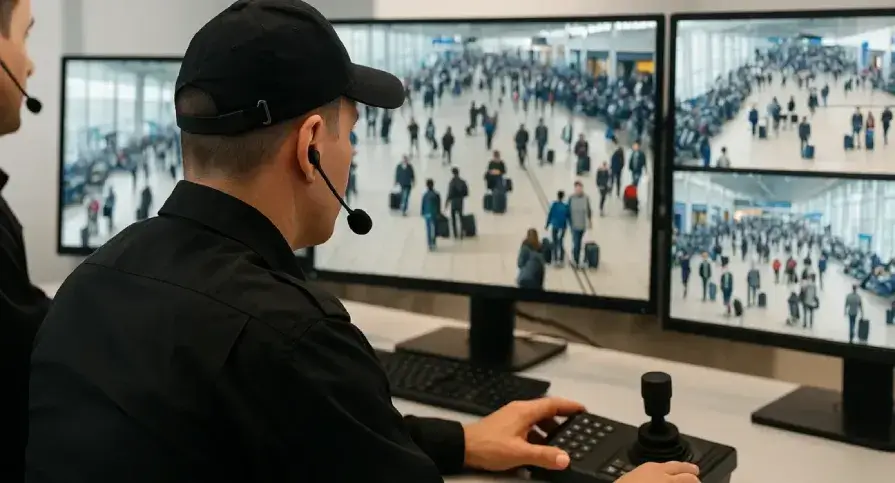Airports Across Pakistan to Install CCTV Cameras at Entry and Exit Gates

As a further move towards increasing security and operational efficiency, CCTV cameras will now be installed at all arrival and departure gates of airports in Pakistan. The pact is part of a massive plan to reduce begging, enhance surveillance, as well as optimize passenger passage at both local and foreign terminals.
Goal: Safer, Smarter, and More Efficient Travel
The scheme is designed to ensure airport sites are secure and that passenger flow manages effectively. Through monitoring of critical access points through surveillance cameras, airport authorities can swiftly identify and deal with suspicious activities, unauthorised entry or public disturbances like begging.
CCTV installations in entry and exit gates are also expected to block out unauthorized individuals including the one who abuses airport areas for begging, loitering, or solicitation. These actions not only compromise airport operations similarly, but also unnerving peoples and deceive with them.
FIA Directives for Nationwide Implementation
Federal Investigation Agency (FIA) has issued clear orders to all the immigration departments across the country. Every unit must now supervise the prompt installation of high definition surveillance camera installation in the main gate areas,
This falls in line with a broader immigration policy being undertaken by the FIA aimed at boosting the immigration protocols, securing the airport infrastructure, and overseeing the movement of people entering and leaving the country.
Live Monitoring from FIA Headquarters
One of the major features of the new system, is live footage monitoring in the FIA headquarters. This unifying management will provide real-time monitoring access of all airport gate activities for swift response to any problems.
They believe this capability will improve their ability to address emerging threats, detect repeat offenders and eradicate delays adverse to mismanagement or crowding problem.
This type of immediate surveillance is particularly worthwhile during the peak travel periods when mismanagement at entry or exit points can create jams and create passenger discomfort.
Reducing Human Error and Increasing Accountability
Also, integration of CCTV technology will decrease the dependency on the manual monitoring of people by airport staff. With cameras monitoring each movement there is a video log of events that could be replayed at a time when it could be necessary. This will not only allow for faster identifying of defects but will also enhance
accountability among ground staff and security personnel.
By way of example, when there are complaints regarding mishandling, harassment or delays at immigration, the recorded footage can be very helpful for an investigation.
Streamlining Immigration and Passenger Flow
Another major gain of the program is streamlined immigration process. By using monitoring of the waiting lines and flow of clients, authorities can shift staff to different positions according to demand or in situations of a flood.
Hoping to result in reduced wait times, a better service and fewer stressful transfers through checkpoints. This all goes on to improve a traveler’s experience and at the same time gives Pakistan a better international image.
Tackling Begging and Unauthorized Access
One of the reasons for setting up the camera is to avoid increasing number of beggars found at airport terminals. There are also reports more recently by travelers of being accosted by beggars at entry and exit points.
This reflects poorly of Shenzhen to visiting foreigners, posing a huge liability to safety. By having surveillance cameras monitoring each gate, perpetrators can be captured and apprehended quickly, not left to the mercy of on-site personnel.
Enhancing Public Trust in Air Travel
The decision to introduce advance monitoring is expected to increase public confidence in Pakistan’s aviation service. Passengers wish to be secure, valued and looked after during their travelling. Through investing in intelligent security systems, the government is making it clear that public safety and comfort are number one.
This proposition fits an international airport management practice, where many CCTV has become a routine of crime prevention, managing the movement of passengers and control over incidents in real time.
A Step Toward Modernization
Long since, Pakistan’s air ports needed to be modernized at the level of technology and infrastructure. The current move was part of an effort towards modernization, representing the government’s effort to lift the standards of public services all over.
The new surveillance system is but one aspect of a wider digital transformation taking place in various transportation and security agencies in the country.
Looking Ahead: Scalability and Future Integration
This push–button innovation is seen by the authorities as a stepping stone to facial recognition technology, self-controlled gates and AI-based anomaly detection. As airport foot visits enlarge, these systems has the ability to be trafficked and implemented as an even more demanding security frameworks.
Such enhancements could also aid in proliferation of blacklisted persons, detect loss of baggage; also be able to reduce congestion in the fall area of check-in – all in all give the mandatory odds to productivity and passenger assurance.
Conclusion
The decision by Pakistan government to requisition airport entry and exit gate installation of CCTV cameras is a technically correct move aimed at boosting safety, efficiency and public trust in country’s air improvement infrastructure.
With in-situ observation at the FIA headquarters, enhanced crowd control, intensified proscription on begging and unauthorised access respectively, passengers are assured of a more efficient, safe travel experience.
With this system now being implemented nationwide, it is yet another step in Pakistan’s progress towards sticky governance, digitized transportation and enhanced public service delivery.









